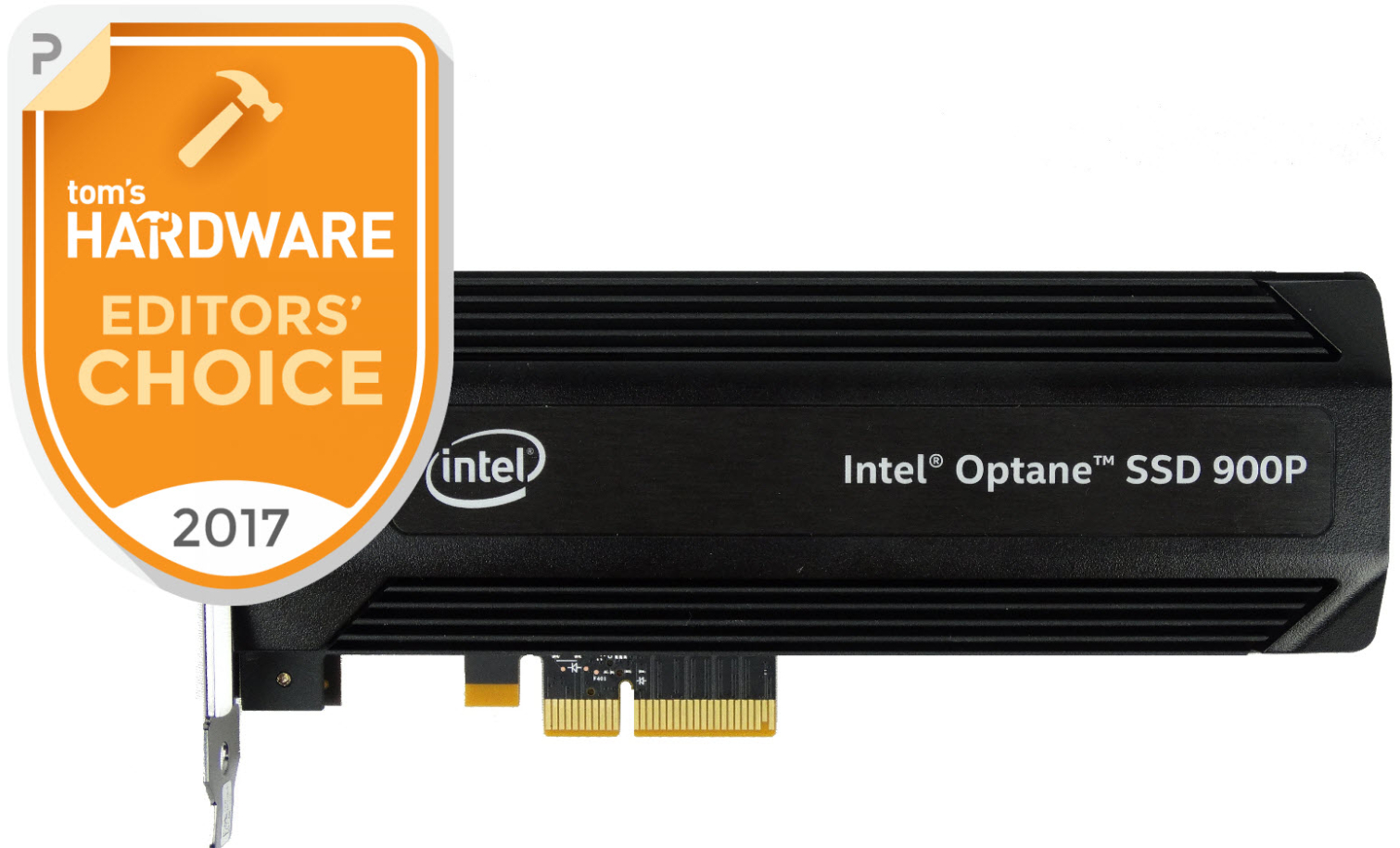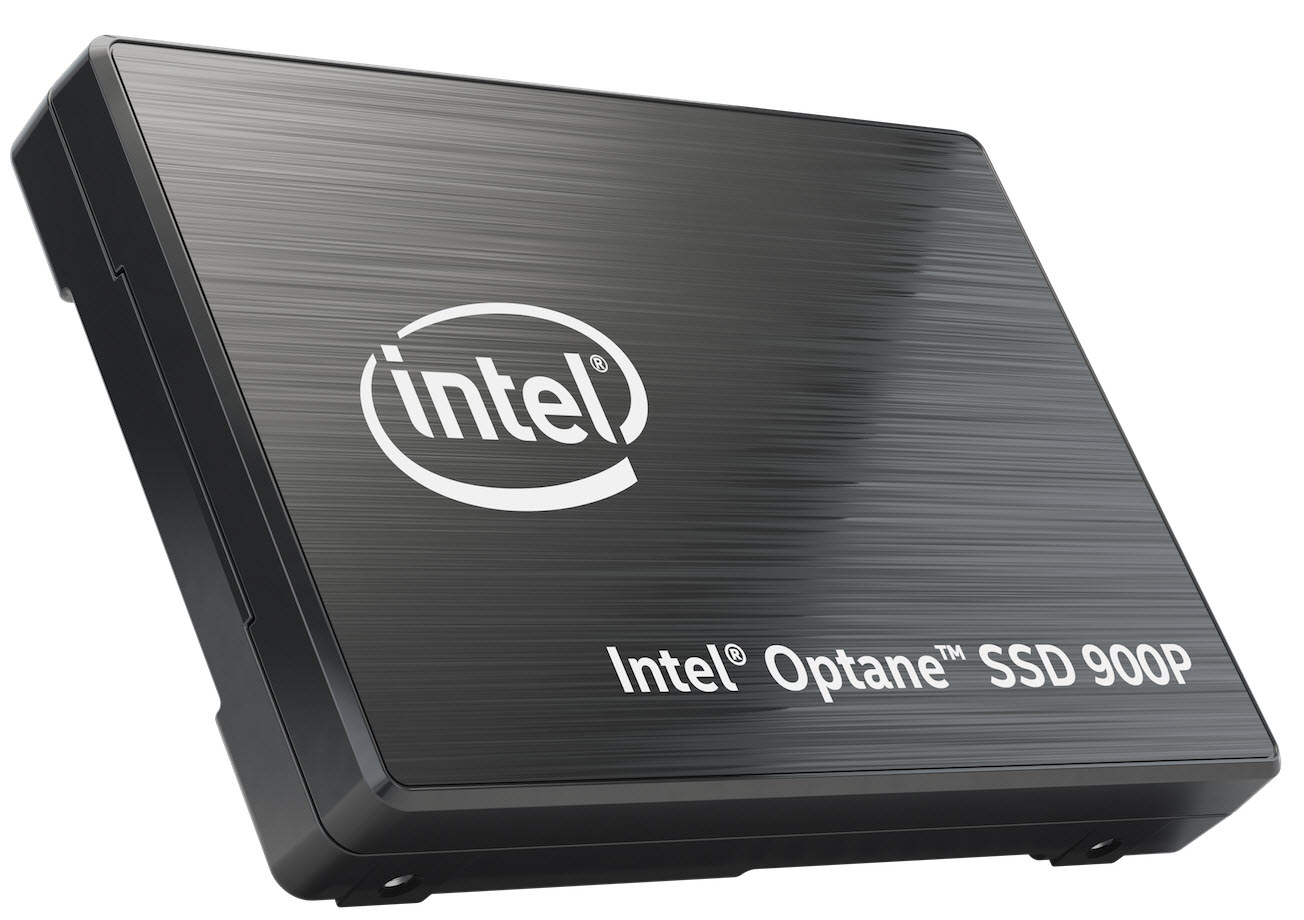Intel Announces First Desktop 3D XPoint Product, Optane SSD 900P
Intel just announced the Optane SSD 900P desktop SSD at CitizenCon, a community gathering of Roberts Space Industries' StarCitizen players event, held in Frankfurt, Germany. The choice of location comes from a partnership between the game developer and Intel. The Optane SSD 900P ships with an exclusive in-game ship, the Sabre Raven. As you might imagine, the ship comes with a special ability that ties in with Optane performance. The Sabre Raven is really fast!
Not to overlook the virtual ship but the real story here is that enthusiasts and power users finally get to take a full bite of Optane technology rather than a sample size nibble.
The Intel Optane SSD 900P will come to market in two capacity sizes, 280GB and 480GB. The series uses two form factors, 2.5" U.2 and half-height, half-length add-in card (AIC). This will start to get confusing so look closely. The 280GB will have two 2.5" models on launch day. One comes with a standard U.2 cable and the second comes with an M.2 to U.2 adapter cable. The 480GB will not ship in a 2.5" form factor until a later date. It will ship in the add-in card form factor starting today.
Regardless of the form factor or capacity size, all Optane SSD 900P drives deliver up to 2,500 MBps sequential read and 2,000 MBps sequential write performance. This is lower than some of the other high-performance NVMe SSDs shipping today, but we will address that in the next section. The drives also deliver up to 550,000 random read and 500,000 random write IOPS performance. This is class leading performance, but there is more to the story.
How Fast Is That?
3D XPoint memory performance is closer to the speed of DRAM than NAND used in SSDs. SSD marketing numbers show maximum performance that comes only at high queue depths. Most of us rarely surpass queue depth 4 and the faster the storage, the less likely you are to even build data requests. This memory addresses the problem with performance at usable workloads.
In the chart above we have the three fastest Intel consumer storage products from different market segments: SATA SSD, NVMe SSD, and Optane NVMe SSD. We've also added the new Seagate BarraCuda Pro 12TB, the fastest consumer hard disk drive shipping today.
Random read performance is what makes your PC feel fast. In the chart above we used the CrystalDisk Mark application to take a quick performance sample. We also presented the data in megabytes per second rather than IOPS to tighten the scale and ease the complexity.
Get Tom's Hardware's best news and in-depth reviews, straight to your inbox.
The move from hard disk drives to flash-based storage was a large performance leap. The next transition from SATA flash to NVMe flash was more of a stumble for many users. NVMe is excellent for complex workloads, but most users don't take advantage of its capabilities. You wouldn't intentionally change what you do on your PC to make your storage work harder.
Intel's Optane 900P compared to a hard disk drive is like flying across the country compared to the previous incremental moves across the performance neighborhood. Even compared to high-speed NVMe SSDs, there is a significant increase using common workloads.
You can read more about the 900P's performance in our detailed review.
Intel's Optane SSD 900P sells for $389 (280GB) and $599 (480GB). We expect products to be ready to ship before the end of the day from your favorite online stores.

Chris Ramseyer was a senior contributing editor for Tom's Hardware. He tested and reviewed consumer storage.
-
derekullo Reply20314252 said:In before scrubs complain that these don't come in SATA 3 flavors.
To be fair, sata 3.2 is 1969 MB/s
https://en.wikipedia.org/wiki/Serial_ATA#SATA_revision_3.2_.2816.C2.A0Gbit.2Fs.2C_1969.C2.A0MB.2Fs.29
Or for that matter give us Sata 4.
-
compprob237 The SSD is being offered with a special bundled ship for Star Citizen right now, too.Reply -
derekullo It depends on the speed of the ram and whether it was in dual channel or not.Reply
A single stick of DDR4-2133 would be capable of 17066.67 megabytes a second.
2 sticks would be double that or 34133 megabytes a second.
The above are theoretical maximums that you probably won't sustain or even reach without a perfect environment
I found this ramdisk benchmark from 2012.
It doesn't show his setup but we can assume its at least DDR3
http://www.donationcoder.com/forum/index.php?topic=32624.0
From my 17 gigabytes a second with a single stick of DDR4-2133 I can calculate that he was using DDR3-1254 or more likely DDR3-1066, rounding down to the nearest standard frequency.
Of course he also could have had a really old ddr2 system being used in dual channel mode.
But you get the idea.
-
AnimeMania Reply20315622 said:I found this ramdisk benchmark from 2012.
It doesn't show his setup but we can assume its at least DDR3
http://www.donationcoder.com/forum/index.php?topic=32624.0
From my 17 gigabytes a second with a single stick of DDR4-2133 I can calculate that he was using DDR3-1254 or more likely DDR3-1066, rounding down to the nearest standard frequency.
Of course he also could have had a really old ddr2 system being used in dual channel mode.
But you get the idea.
So, from that data the Crystaldisk Mark 4KB QD1 for DDR2/DDR3 RAM was between 564 to 1068 or 2 to 4 times faster than Optane. So am I correct in assuming DDR4 is 6 times faster than Optane and Optane is 6 times faster than a SSD for this metric. -
Ed Chombeau IC new destops havin "Intel Optane Memeory" included with a HDD; is this a s good as this SSD.?Reply -
AnimeMania Reply20317311 said:IC new destops havin "Intel Optane Memeory" included with a HDD; is this a s good as this SSD.?
Read the other article, at first I thought they were the same, but it is way more in depth. It includes data about the Optane/hard drive combo that seems really impressive.
http://www.tomshardware.com/reviews/intel-optane-ssd-900p-3d-xpoint,5292.html -
Fluffy_Hedgehog Reply20314550 said:20314252 said:In before scrubs complain that these don't come in SATA 3 flavors.
To be fair, sata 3.2 is 1969 MB/s
https://en.wikipedia.org/wiki/Serial_ATA#SATA_revision_3.2_.2816.C2.A0Gbit.2Fs.2C_1969.C2.A0MB.2Fs.29
Or for that matter give us Sata 4.
the problem with sata in this respect is overhead and latency not throughput.
290MB are not an issue for Sata in its current version but the IOPS are.
The main difference between SATA and NVME is less signaling overhead allowing much lower latency between calls. 500.000 IOPS is out of Satas reach, so a drive like that does not make much sense (at least not until market permiation allows for "low end" optane drives).



